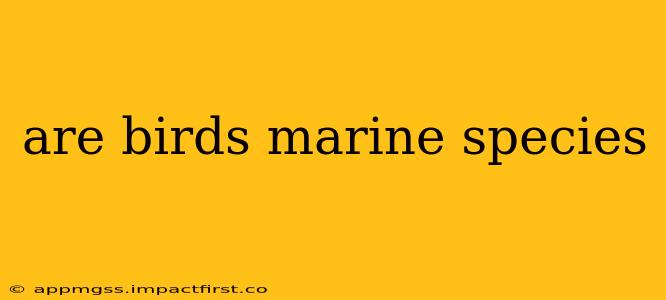The question of whether birds are marine species isn't a simple yes or no. While not all birds are marine, a significant number have adapted to and thrive in marine environments, exhibiting remarkable adaptations for survival in the ocean. This means the answer is nuanced and depends on how we define "marine species."
What Defines a Marine Species?
Before we delve into the specifics of avian marine life, let's define what constitutes a marine species. Generally, a marine species is an organism that spends a significant portion of its life cycle in saltwater environments – oceans, seas, and saltwater estuaries. This encompasses various aspects of their life, including feeding, breeding, and shelter. Therefore, a bird's interaction with the marine ecosystem is key to classifying it as marine or not.
Types of Marine Birds: A Diverse Group
Many bird species display a strong affinity for the ocean, showcasing diverse adaptations depending on their ecological niche. These marine birds can be broadly categorized into:
-
Pelagic Birds: These birds spend most of their lives at sea, far from land. Examples include albatrosses, petrels, and shearwaters, renowned for their incredible endurance and ability to fly vast distances over open water.
-
Coastal Birds: These birds primarily inhabit coastal regions, utilizing shorelines, estuaries, and near-shore waters for feeding and breeding. This group encompasses a wide variety of species, including gulls, terns, penguins (in certain regions), and many waders (shorebirds).
-
Diving Birds: Many birds, like cormorants, gannets, and penguins, have evolved exceptional diving skills to hunt fish and other marine life underwater. These adaptations often include streamlined bodies, webbed feet, and specialized vision.
How Birds Adapted to Marine Life
The remarkable diversity among marine birds stems from their specific adaptations to a challenging environment. These include:
-
Salt Glands: Many marine birds possess specialized salt glands above their eyes that effectively excrete excess salt ingested through seawater or prey.
-
Waterproof Feathers: A dense, oily plumage provides exceptional waterproofing, preventing them from getting soaked and losing body heat in cold waters.
-
Webbed Feet: Webbed feet are crucial for efficient propulsion through water, allowing these birds to swim and dive with ease.
-
Specialized Beaks: Bird beaks have evolved to match their prey. For instance, sharp beaks are ideal for catching fish, while those with hooked tips are well-suited for consuming crustaceans or other invertebrates.
Frequently Asked Questions (PAA)
Here are some common questions people have about birds and their relationship with the ocean, addressed using the best available information:
Are all birds that live near the ocean considered marine birds?
No, not all birds that live near the ocean are considered marine birds. While many birds frequent coastal areas for foraging, only those that depend heavily on the marine environment for their entire life cycle (feeding, breeding, resting) qualify as true marine species. Many shorebirds, for example, might feed on the shoreline but also nest and roost inland.
What are some examples of marine birds?
Examples of marine birds include albatrosses, penguins, gannets, cormorants, gulls, terns, and petrels. The specific species will vary depending on geographic location.
Do all marine birds have webbed feet?
While webbed feet are common in many marine birds, especially those that rely on swimming for hunting, not all marine birds possess them. Some species, like certain types of gulls and terns, have unwebbed feet, highlighting the diversity of adaptations in this group.
How do marine birds survive in salt water?
Marine birds have evolved several adaptations to survive in saltwater environments. These include salt glands to excrete excess salt, waterproof feathers to insulate against cold temperatures and prevent waterlogging, and specialized beaks and feet for efficient foraging and swimming.
In conclusion, while not all birds are marine, a significant and diverse group of avian species are deeply integrated into marine ecosystems. These birds showcase remarkable adaptations that allow them to thrive in a challenging environment, highlighting the intricate relationship between birds and the ocean.
